|
|
St Gregory the Wonderworker, Bishop of Neocaesarea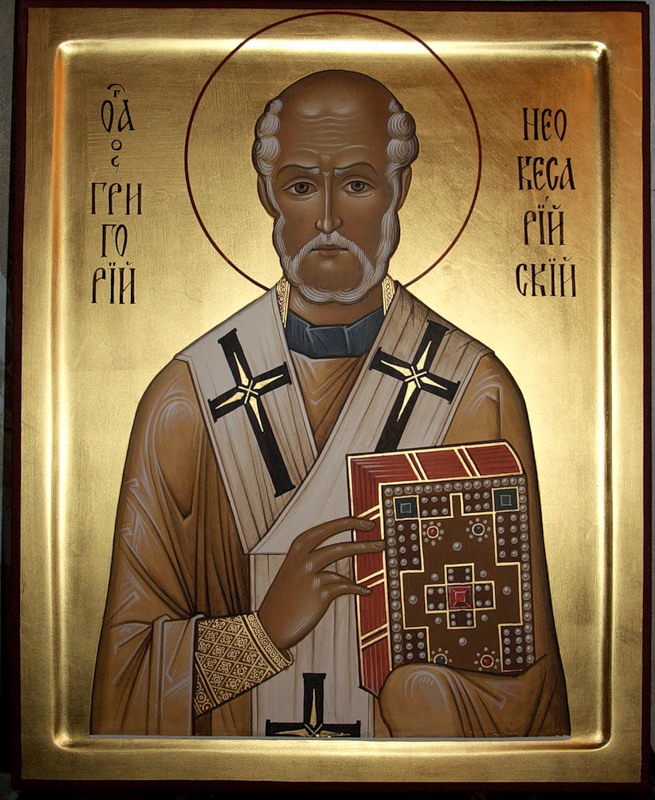 Here is a man of God and a mighty wonderworker, who was called a second Moses! Born of wealthy and eminent pagan parents, Gregory at first studied Hellenic and Egyptian philosophy, but, seeing its barrenness and insufficiency, he turned to Christian teachers, particularly Origen of Alexandria, with whom he studied for several years and by whom he was baptised. Pure in soul and body, he desired to consecrate himself utterly to Christ, to which end he withdrew to the desert, where, in painful asceticism, he spent many years. His fame spread abroad everywhere, and Phaedimus, the bishop of Amasea, wanted to make him Bishop of Caesarea. The discerning Gregory was warned of Phaedimus's intention, and hid in the wilderness from those sent to find him, so that they failed in their quest. Finally, Phaedimus consecrated him by devious means, and Gregory had to accept the work of a shepherd. The most holy Mother of God appeared to him, together with St John the Theologian, and, at her command, St John gave him the Creed that is known by Gregory's name.* Who can enumerate the miracles of this second Moses? He commanded evil spirits, commanded mountains and waters, healed every sort of pain and ill, became invisible to his persecutors and had insight into both distant events and men's thoughts. He finished his earthly course in the year 270, in great old age. When he arrived in Caesarea as bishop, the whole town was composed of pagans, with just seventeen Christians. When he departed this life, the whole town was Christian, with just seventeen pagans. He therefore received a wreath of glory from his Lord in the heavenly Kingdom.
*The Nicene Creed, that Gregory was instrumental in establishing at the Second Ecumenical Council in 381 - Tr. Here is a man of God and a mighty wonderworker, who was called a second Moses! Born of wealthy and eminent pagan parents, Gregory at first studied Hellenic and Egyptian philosophy, but, seeing its barrenness and insufficiency, he turned to Christian teachers, particularly Origen of Alexandria, with whom he studied for several years and by whom he was baptised. Pure in soul and body, he desired to consecrate himself utterly to Christ, to which end he withdrew to the desert, where, in painful asceticism, he spent many years. His fame spread abroad everywhere, and Phaedimus, the bishop of Amasea, wanted to make him Bishop of Caesarea. The discerning Gregory was warned of Phaedimus's intention, and hid in the wilderness from those sent to find him, so that they failed in their quest. Finally, Phaedimus consecrated him by devious means, and Gregory had to accept the work of a shepherd. The most holy Mother of God appeared to him, together with St John the Theologian, and, at her command, St John gave him the Creed that is known by Gregory's name.* Who can enumerate the miracles of this second Moses? He commanded evil spirits, commanded mountains and waters, healed every sort of pain and ill, became invisible to his persecutors and had insight into both distant events and men's thoughts. He finished his earthly course in the year 270, in great old age. When he arrived in Caesarea as bishop, the whole town was composed of pagans, with just seventeen Christians. When he departed this life, the whole town was Christian, with just seventeen pagans. He therefore received a wreath of glory from his Lord in the heavenly Kingdom.
*The Nicene Creed, that Gregory was instrumental in establishing at the Second Ecumenical Council in 381 - Tr.Our Holy Father Nikhon of Radonezh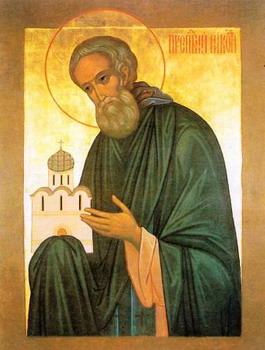 He was a disciple of St Sergius of Radonezh, and followed him as abbot. When the barbarians fell on Russia, he prayed to God to preserve the Russian people from this misfortune. St Sergius appeared to him, together with St Peter and St Alexis, the departed Metropolitan of Moscow, and told him not to be downcast, for the invasion was by God's permission for the good of the people, but that it would pass and peace would reign once more. He entered into rest on November 17th, 1426. He was a disciple of St Sergius of Radonezh, and followed him as abbot. When the barbarians fell on Russia, he prayed to God to preserve the Russian people from this misfortune. St Sergius appeared to him, together with St Peter and St Alexis, the departed Metropolitan of Moscow, and told him not to be downcast, for the invasion was by God's permission for the good of the people, but that it would pass and peace would reign once more. He entered into rest on November 17th, 1426.Our Holy Father Gennadius of Vatopedi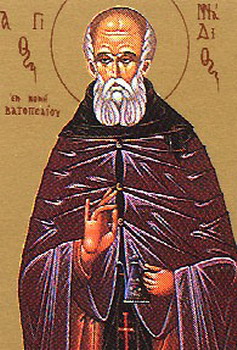 A monk of Vatopedi, he had the obedience of steward. By his agency, a dry well was miraculously filled with oil. This miracle was ascribed to the most holy Mother of God, to whom the monastery is dedicated, and to an icon of hers that stood nearby. A monk of Vatopedi, he had the obedience of steward. By his agency, a dry well was miraculously filled with oil. This miracle was ascribed to the most holy Mother of God, to whom the monastery is dedicated, and to an icon of hers that stood nearby.Venerable Lazarus the iconographer of Constantinople (857)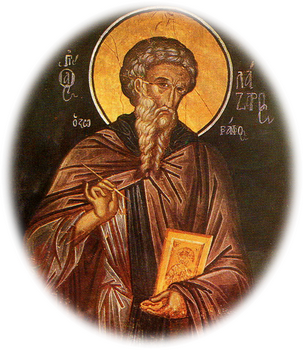 The Holy Monk Lazaros the Iconographer lived in Constantinople. He was a priest, led a strict ascetic life and wrote holy icons. Under the Iconoclast emperor Theophilos (829-842), they arrested him and after cruel tortures they threw him in prison. He was saved from an inevitable execution by the intervention of the empress Theodora. The Monk Lazaros died in the year 857 while returning from Rome, where he had been sent in a delegation on church matters to Pope Benedict III (855-858). His remains were taken to Constantinople and buried in the church of Saint Euandros. The Holy Monk Lazaros the Iconographer lived in Constantinople. He was a priest, led a strict ascetic life and wrote holy icons. Under the Iconoclast emperor Theophilos (829-842), they arrested him and after cruel tortures they threw him in prison. He was saved from an inevitable execution by the intervention of the empress Theodora. The Monk Lazaros died in the year 857 while returning from Rome, where he had been sent in a delegation on church matters to Pope Benedict III (855-858). His remains were taken to Constantinople and buried in the church of Saint Euandros.Martyrs Zachariah the Cobbler and his wife, Mary (3rd c.)
Martyr Gobron (Michael) and 133 soldiers of Georgia (914)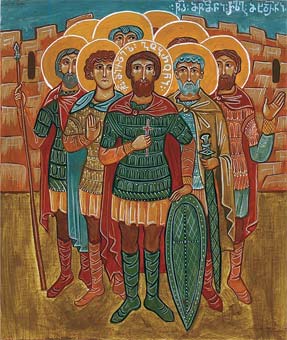 In the year 914 a certain prince by the name of Michael-Gobron distinguished himself in a battle against the Arab Muslim invaders. After they had captured the fortress of Kvelistsikhe in southern Georgia, the Muslims took captive those who remained alive, and Prince Gobron was among them. Deeply impressed by the Georgian soldier’s valor, the emir Abu al-Qasim ordered his army to treat him with respect... In the year 914 a certain prince by the name of Michael-Gobron distinguished himself in a battle against the Arab Muslim invaders. After they had captured the fortress of Kvelistsikhe in southern Georgia, the Muslims took captive those who remained alive, and Prince Gobron was among them. Deeply impressed by the Georgian soldier’s valor, the emir Abu al-Qasim ordered his army to treat him with respect...St. Gennadius, patriarch of Constantinople
St. Maximus (Maximian), patriarch of Constantinople (434)
Venerable Longinus of Egypt (4th c.)Our holy Father Longinus lived in the Egyptian deserts during the fourth or fifth century. Among other sayings of his, are the following: A dead man judges no one, and it is just the same with the man who is humble. To someone who wanted to go to live in exile, he replied: Unless you guard your tongue, you will not be able to live in exile wherever you go. To someone else who wanted to live in solitude, he said: If you do not exercise the virtues in the midst of men, still less will you be able to do so in solitude. By his life and his words he taught love of humility as superior to all the works of ascesis, saying: Fasting humbles the body, vigil purifies the intellect and stillness leads to the affliction that baptizes man anew and cleanses him of all sin.
We also owe to him the famous saying: Shed your blood and receive the Spirit.
St. Sebastian (Dabovich) of Jackson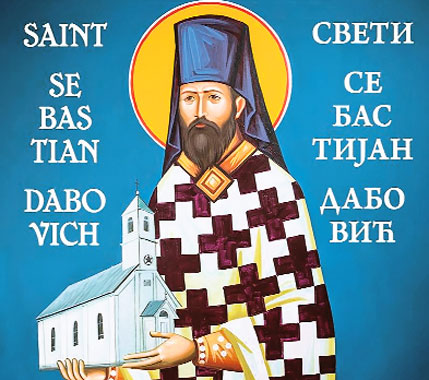 Born to Serbian immigrants in San Francisco in 1863, Archimandrite Sebastian Dabovich has the distinction of being the first person born in the United States of America to be ordained as an Orthodox priest, and also the first native-born American to be tonsured as an Orthodox monk. His greatest distinction, however, lies in the tremendous apostolic, pastoral, and literary work that he accomplished during the forty-eight years of his priestly ministry. Known as the “Father of Serbian Orthodoxy in America,” he was responsible for the founding of several of the first Serbian churches in the New World. This, however, was only one part of his life’s work, for he tirelessly and zealously sought to spread the Orthodox Faith to all peoples, wherever he was called. He organized parish communities of Orthodox Christians of varied ethnic backgrounds; took part in the work of St. Alexis Toth of Wilkes-Barre to bring former Uniates more fully into the Orthodox ethos and way of life; and labored to bring Episcopalians into the saving enclosure of the Orthodox Church. He was an Orthodox apostle of universal significance. Born to Serbian immigrants in San Francisco in 1863, Archimandrite Sebastian Dabovich has the distinction of being the first person born in the United States of America to be ordained as an Orthodox priest, and also the first native-born American to be tonsured as an Orthodox monk. His greatest distinction, however, lies in the tremendous apostolic, pastoral, and literary work that he accomplished during the forty-eight years of his priestly ministry. Known as the “Father of Serbian Orthodoxy in America,” he was responsible for the founding of several of the first Serbian churches in the New World. This, however, was only one part of his life’s work, for he tirelessly and zealously sought to spread the Orthodox Faith to all peoples, wherever he was called. He organized parish communities of Orthodox Christians of varied ethnic backgrounds; took part in the work of St. Alexis Toth of Wilkes-Barre to bring former Uniates more fully into the Orthodox ethos and way of life; and labored to bring Episcopalians into the saving enclosure of the Orthodox Church. He was an Orthodox apostle of universal significance. |